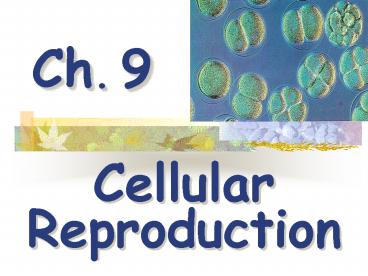Cellular Reproduction - PowerPoint PPT Presentation
1 / 56
Title: Cellular Reproduction
1
Ch. 9
- Cellular Reproduction
2
I. Cellular Growth
- - Cells grow until they reach their size limit,
then they either stop growing or divide.
3
A. Cell Size Limitations
- - Why are cells so small?
4
1. Ratio of Surface Area to Volume
- - As a cell grows, its volume increases faster
than its surface area.
5
1. Ratio of Surface Area to Volume
- - As a cell grows, its volume increases faster
than its surface area.
6
1. Ratio of Surface Area to Volume
- - As a cell grows, its volume increases faster
than its surface area. - - Large cells dont have enough surface area
(cell membrane) to support the cell with food and
oxygen by diffusion.
7
2. Transport of Substances
- - Most materials (O2, CO2, water, wastes, etc.)
enter and exit the cell by diffusion. - - Diffusion is efficient only over very short
distances.
8
3. Cellular Communications
- - If the cell is too large, it cannot make
proteins fast enough to support itself.
9
B. The Cell Cycle
- - Cell reproduction enables an organism to grow,
heal injuries, or to reproduce.
Sea Urchin Embryo
10
B. The Cell Cycle
- - Cell reproduction enables an organism to grow,
heal injuries, or to reproduce.
Mitotic cell division Differentiation
Multicell stage (embryo)
Fertilized egg (zygote)
Tissues
11
Asexual Reproduction by Mitosis
12
Asexual Reproduction by Mitosis
13
- - The cell cycle is a continuous process
consisting of 3 stages Interphase, Mitosis,
and Cytokinesis. - - Takes place in 12 24 hours.
14
1. Interphase
- - Stage of normal cell activity, growth, and DNA
replication. - - Occurs in 3 phases
15
- a) G1 cell growth and normal activity
- b) S DNA replication
- - Chromosomes structure in nucleus that
contain DNA - - Chromatin active, extended form of
chromosomes - c) G2 preparation for mitosis
16
Chromosome Structure
17
2. Mitosis
- - Division of the nucleus
18
3. Cytokinesis
- - Division of the cell into 2 identical
daughter cells
19
4. Prokaryotic Cell Division
- - Binary fission simple cell division
E. coli
20
Binary Fission in Bacteria
21
Binary Fission in Bacteria
22
II. Cell Division
- - Mitosis and Cytokinesis
- A. Mitosis
- - 4 stages (P, M, A, T)
Prophase
Anaphase
Metaphase
Telophase
23
1. Prophase
- - first and longest stage
- a. Chromatin condenses to form chromosomes.
- - Each replicated chromosome consists of 2
identical sister chromatids - attached at the centromere.
24
Human Chromosomes
25
- b. Nuclear membrane and nucleoli disappear.
- c. Spindle fibers form
- - microtubule structures that aid in movement
of chromosomes - d. Centrioles move to opposite ends of the
cell (animal cells only).
26
2. Metaphase
- - second and shortest stage
- - Chromosomes line up along the middle of the
cell.
27
3. Anaphase
- - Centromeres split and chromosomes move apart to
opposite sides of the cell.
28
4. Telophase
- - last stage
- - "reverse" of prophase
- a. Chromosomes revert to chromatin.
- b. Spindle fibers disappear.
- c. Nuclear membrane and nucleolus reform.
29
B. Cytokinesis
- 1. Animal Cells
- - Cell membrane pinches in forming 2 daughter
cells.
30
2. Plant Cells
- - Cell plate forms between 2 daughter cells.
31
Which stage of the cell cycle?
Anaphase
32
Which stage of the cell cycle?
Interphase
33
Which stage of the cell cycle?
Metaphase
34
Which stage of the cell cycle?
Prophase
35
Which stage of the cell cycle?
Telophase
36
Which stages of the cell cycle?
37
Which stage of the cell cycle?
Early Anaphase
38
Which stage of the cell cycle?
Metaphase
39
Which stage of the cell cycle?
Prophase
40
Which stage of the cell cycle?
Telophase
41
III. Cell Cycle Regulation
- - The timing and rate of cell division varies by
cell type.
42
A. Normal Cell Cycle
- - Cell division is complex, crucial, and highly
regulated. - 1. Cyclins and Cyclin-dependent Kinases (CDKs)
- - Various combinations trigger different
stages of the cell cycle. - 2. Quality Control Checkpoints
- - Coordinate important events in the cell
cycle.
43
B. Abnormal Cell Cycle Cancer
- - disease in which cells have lost the ability to
control their own growth
44
1. Causes of Cancer
- - due to changes in a gene (mutations) that
controls cell division
45
- - Carcinogens cancer causing agents (asbestos,
tobacco smoke, dioxin, UV radiation, X rays)
46
2. Cancer Genetics
- - More than 1 mutation is required to produce a
cancer cell. - - Some genes that lead to cancer (oncogenes)
can be inherited.
47
3. Characteristics of Cancer Cells
- a) Rapid cell division
- b) Undifferentiated cells
- c) Metastasis
- - cells don't stick together and can
move elsewhere
48
C. Apoptosis
- - programmed cell death
- - occurs in worn out cells and during embryonic
development
49
Fate Map of Cell Lineage in C. elegans
50
Caenorhabditis elegans Adult crawling
51
C. elegans Embryonic Development
52
D. Stem Cells
- - unspecialized cells that can differentiate into
specialized cells
53
1. Embryonic Stem Cells
- - Cells from an early embryo that can
differentiate into any cell type.
54
2. Adult Stem Cells
- - Cells found in various tissues that can
regenerate several types of tissues where they
are found.
55
The End
56
C. Apoptosis
- - programmed cell death
- - occurs in worn out cells and during embryonic
development

